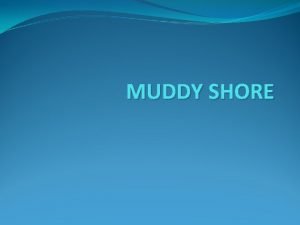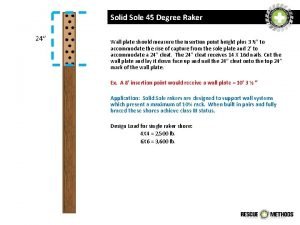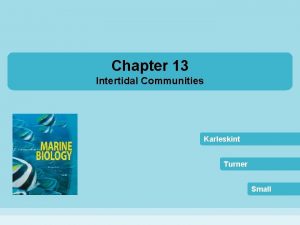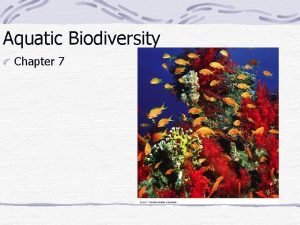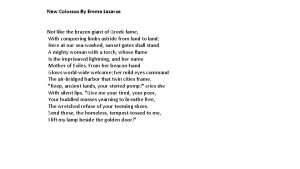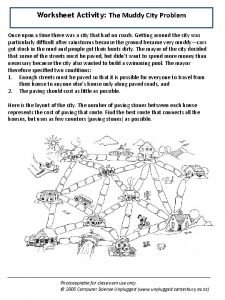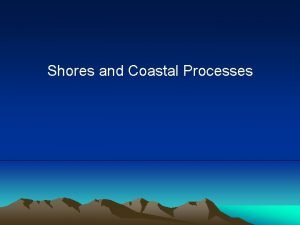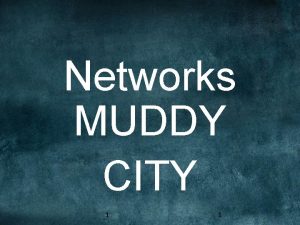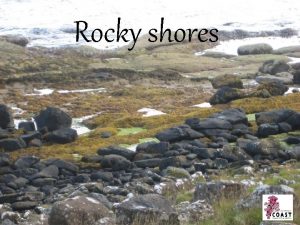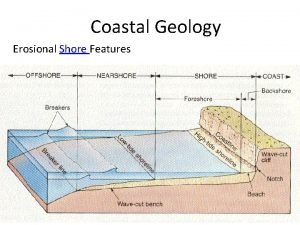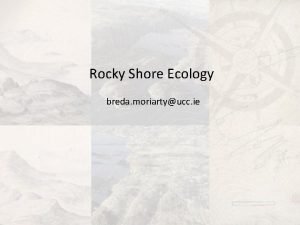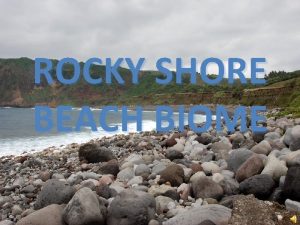MUDDY SHORE INTRODUCTION Muddy shores are formed along
















- Slides: 16

MUDDY SHORE

INTRODUCTION Muddy shores are formed along the seashores where there is no or little wave action. These intertidal areas are formed by the deposition of silt from the water flowing into the sea. Muddy shores are quite common along the sheltered beaches, estuaries and mangroves. The mud is also known for its high organic carbon content and hence serves as a very good food source for many of the mud dwelling organisms. These shores are just opposite to the sandy beaches, which is mainly formed along the beaches of moderate or strong wave action and hence this is just opposite to that of sandy shores both in the nature of substratum as well as in the faunal and floral composition

PHYSICAL FACTORS 1. Wave action • Muddy shores are developed only along the shores of mild wave action and therefore these shores restricted to the intertidal areas of enclosed bays, lagoons and especially estuaries. • Mild wave action facilitates the fine grained particles brought in by the freshwaters to settle and form muddy substratum or mud flats. • Furthermore, these areas are stable than sand substrates and more conductive to the establishment of permanent burrows.

2. Substratum As this area is having very fine particles and flat surface, it is known to retain high amount of interstitial water with in the substrate. This retention of water in its interstitial space for long time leads to the poor exchange of water and high load of microbes in it may results in the formation of anoxic condition below the surface of the sediments.

Between the upper aerobic layer and the lower anaerobic layer is a transition zone called the redox potential discontinuity (RPD) layer. Below the RPD zone, sediments are anaerobic and decomposition of organic compounds is by anaerobic bacteria. In the RPD zone, chemoautotrophic bacteria are the common forms present.

3. Temperature and salinity • Fluctuations in temperature and salinity, though present in the muddy shores, are not very significant. • These are effectively buffered by the mud. The slow interchange of interstitial water is mainly responsible for the maintenance of nearly constant salinity in the muddy substratum. • Moreover, the variations at the surface do not significantly affect the organisms, as most of them are burrowers living deep inside the mud.

4. Organic materials • Muddy shores tend to accumulate organic material. • There is an abundant potential food supply for the resident organisms, but the abundant small organic particles “raining” down on the mud flat also have the potential to clog respiratory surfaces.

TYPES OF ORGANISMS In contrast to sandy beaches, muddy shores often develop a substantial growth of various plants. On the bare mud flats, the most abundant plants are diatoms, which live in the surface layers of mud and often give brownish colour to the surface or low tide. Other plants include large macro algae, such as species of Gracilaria (red algee), Ulva, and Enteromorpha (green algae). Other areas, particularly the lowest tidal levels, may be covered with a growth of various sea grasses, such as the genus Zostera. As a result of the occurrence of these primary producers, there is substantial primary productivity in the mud flats.

• Mud flats contain large numbers of bacteria, which feed on the abundant organic matter. • These bacteria are capable of using the potential energy of the various reduced chemical compounds abundant here. • These chemolitho autotrophic or sulphur bacteria obtain energy through the oxidation of a number of reduced sulphur compounds, such as various sulphides (e. g. H 2 S). • These organisms are thus primary producers of organic matter analogous to green plants. • They produce organic matter using energy obtained from the oxidation of the reduced sulphur compounds,

• Since these autotrophic bacteria are located in the RPD layer of mud, mud flats are unique among marine environments in that they have two separate layers in which primary productivity occurs: • Surface layer-where diatoms, algae and marine grasses carry on photosynthesis; • deep layer-where bacteria conduct chemosynthesis. • The dominant macro faunal groups on muddy shores are the same as those encountered on sand beaches and sandflats namely, various polychaetes worms, bivalve molluscs, and small and large crustaceans, but of different sorts.

FEEDING BIOLOGY The dominant feeding types on mud flats are deposit feeders and suspension feeders Deposit feeders are generally abundant as this area is abound with organic matter as well as large populations of bacteria in the sediments. Deposit feeding polychaetes include the genera such as Arenicola and Capitella. These polychaetes feed by burrowing through the mud, ingesting it and digesting out the organic matter including bacteria and passing out the undigested material through anus.

• Arenicola lives in a U-shaped burrow, in which one end of the burrow is permanently open shaft to the surface, called tail shaft and the other end of the burrow is filled with sediment which the worm ingests. • Capitellids on the other hand, form no permanent tubes but move like earthworms through the surface layers of the sediment and ingesting it. • Apart from these deposit feeders, the species of surface feeding terebellid polychaetes and the burrowing hemichordates are also represented here. • The deposit feeding bivalves included are the species of Macoma and Scrobicularia. .

• Suspension feeders include the species such as various species of clams ( Mya arenaria, Macoma balthica), • General deposit feeders are more common in fine grained shores and suspension feeders become more abundant in coarser sediments where there is very little organic matter. • The common carnivorous animal on the muddy shores included are mainly fishes (e. g. Periophthalmus sp. ). • Indigenous mud flat predators include a few polychaete worms (Glycera sp. ), moon snails (Natica, Polinices), nemertean worms and crabs.

ZONATION As in any other intertidal areas, zonation can also be recognised in muddy shores. The very gentle slope of these areas offers very extensive and wide beaches than the rocky and sandy shores. 1. The supra-littoral fringe or terrestrial zone: It is often uninhabited by any organisms. In some coats, this zone is occupied by salt marshes or mangroves. 2. The mid littoral region : It is mostly inhabited by the burrowing mollusc such as Cardium, and Macoma 3. The sub-littoral fringe area : It is inhabited by polychaetes.

ADAPTATIONS 1. Burrowing mode of life Muddy shore organisms are adapted to burrowing into the soft substratum or construct tubes and live inside the tubes as these areas are with increased stability due to the presence of fine sediments. • For burrowing into the mud, these organisms possess the digging organs (i. e. foot). • 2. Feeding adaptations • Most of muddy shore organisms adapted for the ciliary mode of feeding as this area is rich in detritus and by this way they prevent the feeding surfaces from clogging by the detritus particles.

3. Ability to tolerate anoxic condition • For the survival in the anoxic muddy sediments, these muddy shore organisms must either be adapted to live under anaerobic conditions or they must have some means to bringing the overlying surface water with oxygen down to them. • For this the muddy shore organisms are known to construct burrows or extending their siphons to the surface, which brings in oxygen rich water as well as food. • Some other organisms are able to live in the anoxic subsurface sediments by possessing the oxygen carriers such as haemoglobin in its blood, which helps the animals to live in a very low oxygen environment (e. g. Anadora granosa).
 Muddy shore biodiversity
Muddy shore biodiversity Antigentest åre
Antigentest åre O captain my captain analysis
O captain my captain analysis Bridge overhang scaffold
Bridge overhang scaffold Solid sole raker
Solid sole raker Angie varona sexting
Angie varona sexting Positive fail safe joint connectors
Positive fail safe joint connectors Rocky shores food web
Rocky shores food web Shores of gitche gumee
Shores of gitche gumee Ocean shores
Ocean shores Rocky shores animals
Rocky shores animals Why does she want the wretched refuse of teaming shores?
Why does she want the wretched refuse of teaming shores? Karen shores
Karen shores Green shores for homes
Green shores for homes Muddy city solution
Muddy city solution Muddy children puzzle
Muddy children puzzle Dusty overalls and muddy boots
Dusty overalls and muddy boots
